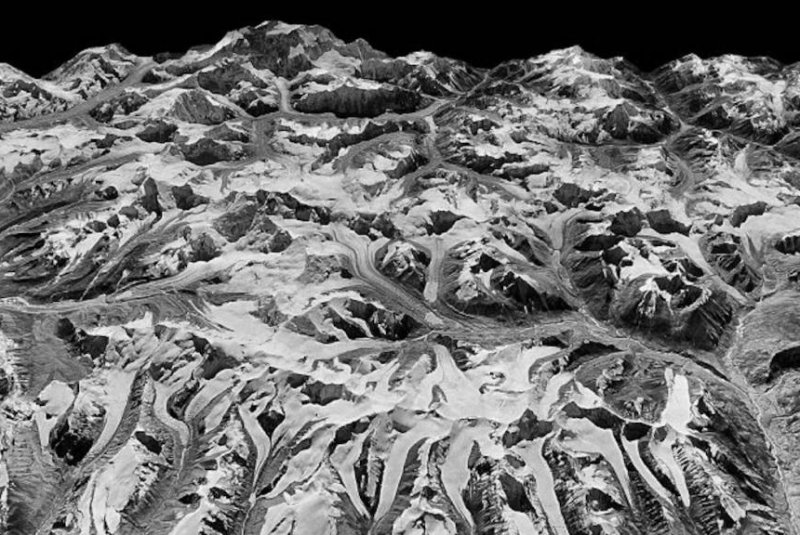The Himalayas on the border of Sikkim, India and eastern Nepal, as seen by the KH-9 HEXAGON spy satellite in December 1975. Photo by National Reconnaissance Office/U.S. Geological Survey
June 19 (UPI) -- Global warming is shrinking the glaciers in the Himalayas. According to a new survey, glaciers in the region have lost roughly a vertical foot and a half of ice.
Scientists compiled data from satellite observations collected over the last 40 years across India, China, Nepal and Bhutan. The analysis, detailed this week in the journal Science Advances, showed glacial melt rates have doubled since the turn of the century.
During the last 18 years, the average glacial melt rate across the world's tallest mountain range was twice what it was between 1975 and 2000.
"This is the clearest picture yet of how fast Himalayan glaciers are melting over this time interval, and why," lead researcher Joshua Maurer, a Ph.D. candidate at Columbia University's Lamont-Doherty Earth Observatory, said in a news release.
Sometimes referred to as planet Earth's "third pole," the Himalayas hosts approximately 600 billion tons of ice. Some 25 percent of the world's 198,000 glaciers are found in the region.
Though a number of studies have considered the impacts of global warming on the Himalayas, most have provided only a snapshot, limited in their temporal and geographic scope. The latest study offers the most comprehensive review yet.
For the study, scientists turned hundreds of images -- including recently declassified images captured by U.S. spy satellites -- into 3D models of the region's 650 glaciers, most of which stretch thousands of miles from east to west.
The analysis showed the region's glaciers lost an average of 10 inches of ice per year between 1975 and 2000. But since the turn of the century, glaciers in the Himalayas have been shedding 20 inches of ice per year. The ice loss isn't uniform across each glacier. Most glaciers are melting most dramatically at lower elevations, with low-lying glacial edges losing as much as 16 feet per year.
Declining levels of snowfall and an increase in soot, caused by fossil fuel burning industries in Asia, are likely contributing to the region's ice loss, but scientists suggest global warming is the primary cause.
Researchers used temperature data collected at ground stations across the region to model the expected effects of warming on ice loss in the region. The simulations predicted the kinds of glacial melt rates their survey revealed.
"It looks just like what we would expect if warming were the dominant driver of ice loss," Maurer said.
Ice and snow in the Himalayas feed the Indus, Brahmaputra and Ganges river systems, which supply drinking water to some 1.4 billion people in Asia. The people of India, Pakistan, China and their less populous neighbors rely on the region's glaciers for irrigation and hydroelectric power.
Though the region's ice may not entirely disappear for some time, increasing melt rates are already putting the region at risk. Many meltwater lakes are becoming dangerously bloated, threatening to break through rocky dams, triggering potentially deadly flash floods.















